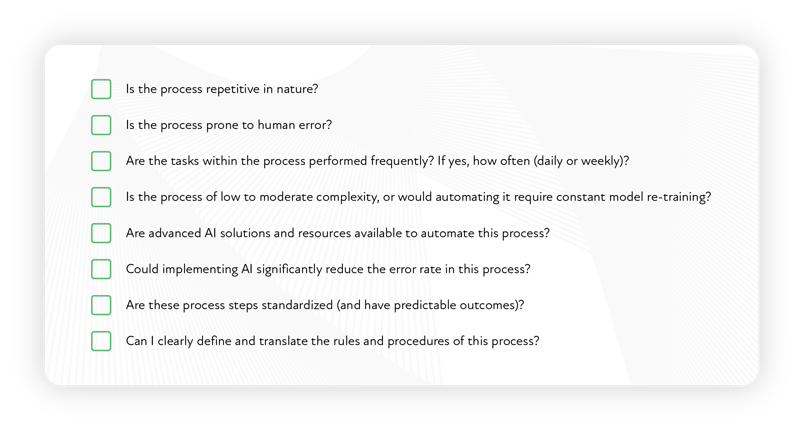Injecting AI into daily tasks can boost outcomes - but only if thoughtfully added to help your team rather than simply replacing them. 85 percent of leaders want to automate processes to increase efficiency and productivity in their organization, and 35 percent want to do it to save costs.
However, whatever outcome you want to boost, automation works best when improving jobs rather than just cutting costs. Many companies need help to get benefits from AI even when they deploy it well. Small projects hit limits. Systems don't talk. There are blindspots from needing more empathy or people skills in models.
A more thoughtful way is carefully putting AI into existing workflows using flexible methods. This automation lets people guide tools to take over dull parts while focusing energy on innovation and judgment calls. The human+AI mix yields more significant gains.
This article outlines four ways to implement automation and structure your systems to let AI evolve seamlessly with your team and your tech at the pace you need.
AI Workflow Automation: 4 Smart Uses
First, it is essential to establish robust pipelines, policies, and access controls at the beginning of the AI adoption process. This lets you effortlessly integrate innovations into workflows and achieve maximum business impact. However, when collaborating with different teams, it is also crucial to implement flexible abstraction layers (preventing fragmented, patchwork systems that may become too rigid and siloed over time).
The right data infrastructure partner plays an invaluable role here—guiding you to bake agility into automation processes from day one. Working with seasoned experts adept at strategic road mapping while rapidly absorbing leading advances equips companies with fluid foundations able to adapt to both near-term optimizations and long-term paradigm shifts.
By instilling upfront resilience and modularity into stack orchestration, the fruits of AI progress can scale efficiently across the business as breakthroughs emerge. Partners like Redapt, with proven methodologies honed through countless successful customer deployments, empower you to implement forward-looking yet pragmatic AI adoption.
1. Map Processes to Automate
First, you want to identify and map out processes suitable for AI automation. This process helps pinpoint repetitive and rule-based tasks and can be taken over by AI. By mapping processes that you need to automate, you ensure that automation is applied where it can deliver the most impact.
That leads to the question, which processes should you automate?
At a time when most businesses are moving towards hyper-automation, you can easily fall into the trap of trying to automate everything. But you can’t just upend and automate all your business processes overnight. You have to prioritize and take it one process at a time.
Consider this yes/no checklist as you try to determine which processes are suitable for AI automation:

You have a strong starting point if the answer to all or most of the above questions is “yes” to whatever process you’re considering.
Then, after identifying key processes ripe for automation, thoughtfully prepare for a successful implementation. Document existing workflows and detail decision trees and potential outcomes in process flowcharts. This contextual roadmap clarifies your as-is scenario before overlaying AI efficiencies. Once you visualize the current state, your operators can evaluate various process automation platforms compatible with your organizational infrastructure.
2. Embed Review Loops Into Your Process
Review loops are a process of incorporating human experts to check the functioning of an AI system at different stages. As the AI models make predictions or automate processes, important outputs are directed toward qualified team members for evaluation. This process involves checking for accuracy, identifying potential bias, labeling false positives to retrain algorithms, or assessing real-world impacts from recommendations.
Embedding these types of feedback milestones enables continuous improvement beyond initial development. Expert team members can still catch nuances missed by AI, provide contextual clarification on model behavior, and guide appropriate adjustments to add more value and safeguard your process. Mastercard, for example, uses human oversight to validate fraud alerts, differentiating between legitimate alarms and false positives.
These insights further inform authentication rules to reduce operational friction. Review loops use this method as an ongoing dialogue between users and algorithms, ensuring accountability and value simultaneously. Over time, this collaboration strengthens AI performance and aligns system actions more tightly with your evolving business objectives.
But how do you get here?
Start by identifying key performance indicators and setting baseline metrics like response times, resolution rates, and user satisfaction to quantify expectations. Designate team members to monitor automation, intervening when necessary by spot-checking quality or evaluating AI workload interactions. Schedule regular reviews for human supervisors to analyze feedback and trends, surfacing insights and anomalies. Collect this data at defined milestones to assess model effectiveness against baselines. Finally, leverage human-centered discoveries to adjust and optimize algorithms over time continuously.
This iterative approach fosters collaboration between man and machine, combining AI scalability with human contextualization to continuously drive system improvements, build accountability, and ensure deployed automation delivers on your intended business value.
3. Architect for Agility
Architecting for agility requires moving from traditional monolithic structures to more flexible, scalable microservices. This shift, supported by open APIs, modular design, cloud tooling, and efficient transition strategies, makes your AI workflow automation systems more adaptable to new data, models, and processes. This architecture offers greater agility, scalability, and resilience but can be more complex to manage. That’s why 85 percent of organizations use microservices architecture.
Software systems that use monolithic architecture have a single, unified code base for all functionalities. These systems are initially simpler to develop but can get cumbersome and inflexible as your application grows. Microservices architecture – an alternative to monolithic systems – consists of small, independent services communicating over well-defined APIs.
To build agile systems, you will need a microservices architecture.
How can you build agile systems? Start here:
- Use publicly available, standardized open APIs to connect systems flexibly, making them easy to integrate into your workflows.
- Consider microservices architecture that lets your operators manage different functionalities independently, making updating and integrating new features easier.
- Adopt a modular approach in pipeline design to update or improve parts independently without overhauling your entire system.
- Use cloud platforms like AWS or Azure for their scalability and range of tools. They support all kinds of deployment needs and adapt to technological changes.
- Start with non-critical functionalities when transitioning from monolithic to microservices.
- Employ orchestration tools like Kubernetes to manage and scale your microservices.
- Implement CI/CD pipelines to automate deployment and ensure agility in the development process.
Enhance AI Workflow Automation With the Right Infrastructure Partner
AI-powered workflow automation can help improve your organization's processes, but its success depends on how you plan and implement it. Partnering with strategic advisors, including your data infrastructure provider, is critical for building adaptable foundations.
Redapt has the expertise to optimize data pipelines and infrastructure to support your new and expanding AI initiatives. And our customized solutions in artificial intelligence and machine learning allow us to provide end-to-end solutions confidently.
From planning to deployment, we will help you leverage AI for improved efficiency and innovation. Book a clarity call with our experts today to get the most out of your AI workflow automation initiatives.
Categories
- Cloud Migration and Adoption
- Enterprise IT and Infrastructure
- Artificial Intelligence and Machine Learning
- Data Management and Analytics
- DevOps and Automation
- Cybersecurity and Compliance
- Application Modernization and Optimization
- Featured
- Managed Services & Cloud Cost Optimization
- News
- Workplace Modernization
- Tech We Like
- AWS
- Social Good News
- Cost Optimization
- Hybrid Cloud Strategy
- NVIDIA
- Application Development
- GPU







